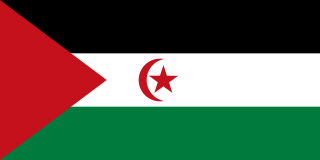
The plazas de soberanía is a term describing a series of unincorporated Spanish overseas minor territories scattered along the Mediterranean coast bordering Morocco. That term is used for those territories that have been a part of Spain since the formation of the modern country (1492–1556), as opposed to African territories acquired by Spain during the 19th and early 20th centuries.

Greater Morocco is a label historically used by some Moroccan nationalist political leaders protesting against Spanish, Portuguese, Algerian and French rule, to refer to wider territories historically associated with the Moroccan sultan. Current usage most frequently occurs in a critical context accusing Morocco, largely in discussing the disputed Western Sahara, of irredentist claims on neighbouring territories.

UTC+01:00 is an identifier for a time offset from UTC of +01:00. In ISO 8601, the associated time would be written as 2019-02-07T23:28:34+01:00. This time is used in:
The individual member states of the African Union (AU) coordinate foreign policy through this agency, in addition to conducting their own international relations on a state-by-state basis. The AU represents the interests of African peoples at large in intergovernmental organizations (IGO's); for instance, it is a permanent observer at the United Nations' General Assembly.

The foreign relations of the Sahrawi Arab Democratic Republic (SADR) are conducted by the Polisario Front, which maintains a network of representation offices and embassies in foreign countries.

The following is an alphabetical list of subregions in the United Nations geoscheme for Africa, used by the UN and maintained by the UNSD department for statistical purposes.
When the African Union (AU) was founded in 2002, it represented almost the entire African continent. As the successor to the Organisation of African Unity (OAU), founded in 1963, its membership was inherited from that body. Currently, the AU has 55 member states. Growth in the OAU typically came from post-colonial independence; as decolonization ended, the borders of the OAU had overlapped almost all of Africa.
In the 1970s in Morocco, after two coup attempts in 1971 and 1972, the patriotism engendered by Morocco’s participation in the Middle East conflict and by the events in Western Sahara contributed to Hassan's popularity and strengthened his hand politically despite serious domestic turmoil. The king had dispatched Moroccan troops to the Sinai front after the outbreak of Arab-Israeli War in October 1973. Although they arrived too late to engage in hostilities, the action won Morocco goodwill among other Arab states. Shortly thereafter, the attention of the government turned to the annexation of then Spanish Sahara from Spain, an issue on which all major domestic parties agreed.

The following outline is provided as an overview of and topical guide to the continent Africa:

The following outline is provided as an overview of and topical guide to the Sahrawi Arab Democratic Republic:

The member states of the African Union are the 55 sovereign states that have ratified or acceded to the Constitutive Act of the African Union to become member states to the African Union (AU). The AU was the successor to the Organisation of African Unity (OAU), and AU membership was open to all OAU member states.
The Sahrawi Arab Democratic Republic (SADR) was proclaimed by the Polisario Front on 27 February 1976, in Bir Lehlu, Western Sahara. SADR claims sovereignty over the entire territory of Western Sahara, a former Spanish colony; however, at present the SADR government controls only about 20–25% of the territory it claims. It calls the territories under its control the "Liberated Territories".

The Sahrawi Arab Democratic Republic and also known as Western Sahara is a partially recognized de facto sovereign state located in the western Maghreb, which claims the non-self-governing territory of Western Sahara, but controls only the easternmost one-fifth of that territory. Between 1884 and 1975, Western Sahara was known as Spanish Sahara, a Spanish colony. The SADR is one of the two African states in which Spanish is a significant language, the other being Equatorial Guinea.
Events in the year 2020 in Morocco.









